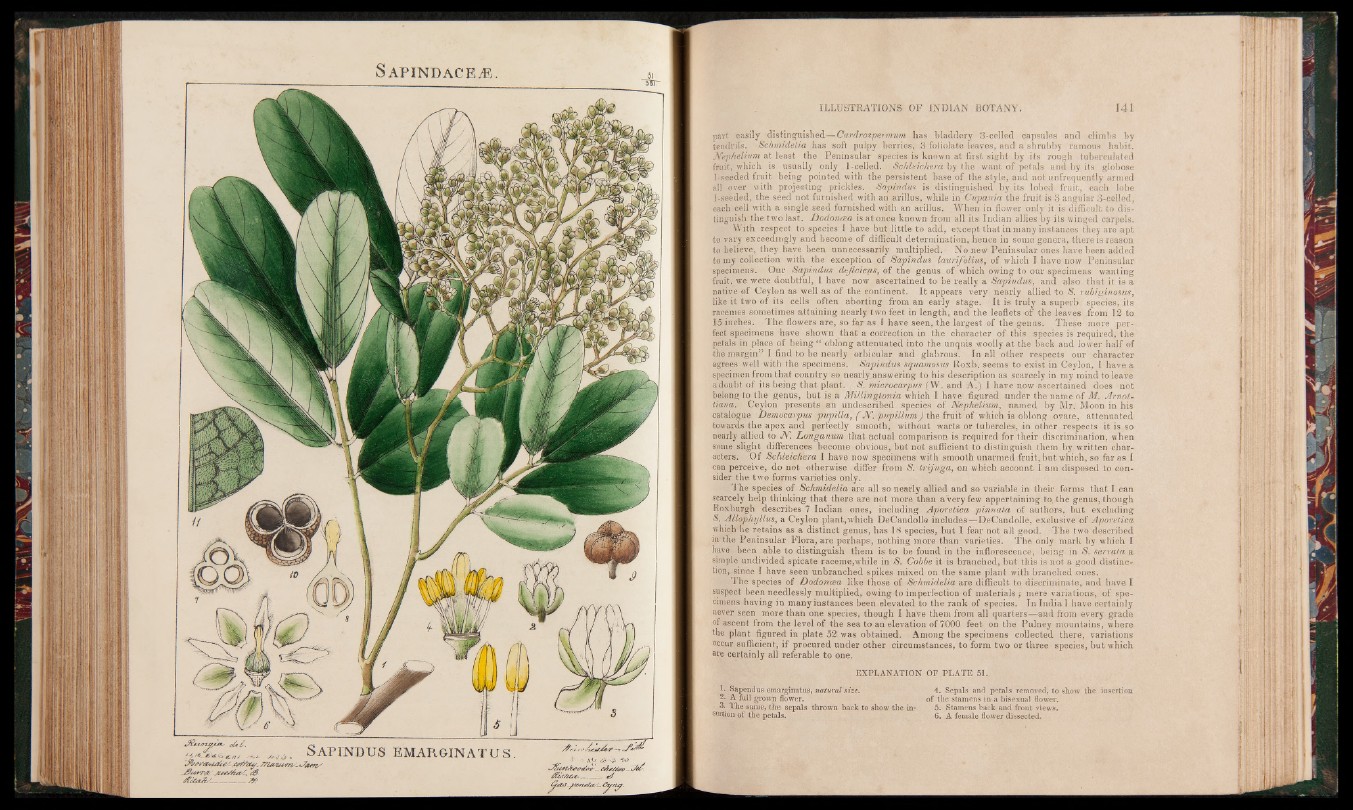
S a p i n d a c e æ .
part easily distinguished—Cardrospermum has bladdery 3-celled capsules and climbs by
tendrils. Schmidelia has soft pulpy berries, 3 foliolate leaves, and a shrubby ramous habit.
Nephelium at least the Peninsular species is known at first sight by its rough tuberculated
fruit, which is usually only 1-celled. Schleichera by the want of petals and by its globose
I-seeded fruit being pointed with the persistent base of the style, and not unfrequently armed
all over with projecting prickles. Sapindus is distinguished by its lobed fruit, each lobe
] -seeded, the seed not furnished with an arillus, while in Cupania the fruit is 3 angular 3-celled,
each cell with a single seed furnished with an arillus. When in flower only it is difficult to distinguish
the two last. Dodoncea is at once known from all its Indian allies by its winged carpels.
With respect to species I have but little to add, except that in many instances they are apt
to vary exceedingly and become of difficult determination, hence in some genera, there is reason
to believe, they have been unnecessarily multiplied. No new Peninsular ones have been added
to my collection with the exception of Sapindus laurifolius, of which I have now Peninsular
specimens. Our Sapindus deficiens, of the genus of which owing to our specimens wanting
fruit, we were doubtful, I have now ascertained to be really a Sapindus, and -also that it is a
native of Ceylon as well as of the continent. It appears very nearly allied to S. rubiginosus,
like it two of its cells often aborting from an early stage. It is truly a superb species, its
racemes sometimes, attaining nearly two feet in length, and the leaflets of the leaves from 12 to
15 inches. The flowers are, so far as I have seen, the largest of the genus. These more perfect
specimens have shown that a correction in the character of this species is required, the
petals in place of being “ oblong attenuated into the unquis woolly at the back and lower half of
the margin” I find to be nearly orbicular and glabrous. In all other respects our character
agrees well with the specimens. Sapindus squamosus Roxb. seems to exist in Ceylon, I have a
specimen from that country so nearly.answering to his description as scarcely in my mind to leave
a doubt of its being that plant. j & microcarpus (W. and A.) I have now ascertained does not
belong to the genus, but is a Millingtonia which I have figured under the name of M. Arnot-
tiana. Ceylon presents an undescribed species of Nephelium, named by Mr. Moon in his
catalogue Democarpus pupilla, fJY. pupillumJ the fruit of which is oblong ovate, attenuated
towards the apex and perfectly smooth, without warts or tubercles, in other respects it is so
nearly allied to JV. Longanum that actual comparison is required for their discrimination, when
some slight differences become obvious, but not sufficient to distinguish them by written characters.
Of Schleichera I have now specimens with smooth unarmed fruit, but which, so far as I
can perceive, do not otherwise differ from S. trijuga, on which account I am disposed to consider
the two forms varieties only.
The species of Schmidelia are all so nearly allied and so variable in their forms that I can
scarcely help thinking that there are not more than a very-few appertaining to, the genus, though
Roxburgh describes 7 Indian ones, including Aporetica pinnata of authors, but excluding
S. Allophyllus, a Ceylon plant,which DeCandolle includes—DeCandolle, exclusive of Aporetica
which he retains as a distinct genus, has 18 species, but I fear not all good. The two described
in the Peninsular Flora, are perhaps, nothing more than varieties. The only mark by which I
have been able to distinguish them is to be found in the inflorescence, being in S, serrat.a a
simple undivided spicate raceme,while in S. Cobbe it is branched, but this is not a good distinction,
since I have seen unbranched spikes mixed on the same plant with branched ones.
The species of Dodoncea like those of Schmidelia are difficult to discriminate, and have I
suspect been needlessly multiplied, owing to imperfection of materials ; mere variations, of specimens
having in many instances been elevated to the rank of species. In India I have certainly
never seen more than one species, though I have them from all quarters—and from every grade
of ascent from the level of the sea to an elevation of 7000 feet on the Pulney mountains, where
the plant figured in plate 52 was obtained. Among the specimens collected there', variations
occur sufficient, if procured under other circumstances, to form two or three species, but which
are certainly all referable to one.
EXPLANATION OF PLATE 51.
1. Sapendus emarginatus, natural size. 4. Sepals and petals removed, to show the insertion
2. A full grown flower. of the stamens in a bisexual flower.
3. The same, the sepals thrown back to show the in- 5. Stamens back and front views,
sertion of the petals. 6. A female flower dissected.